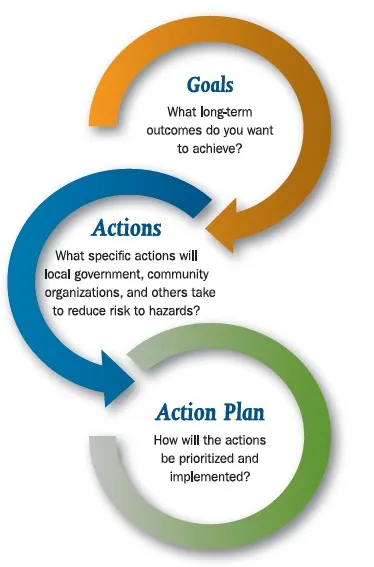A natural hazard mitigation plan update requires extensive review and stakeholder input to ensure the plan is up-to-date and relevant to the current hazards. This page lists the steps taken during the planning process.

Who participates in the planning process?
This essential step includes identifying and organizing interested members of the community as well as the technical expertise required during the planning process. There are multiple levels of participation:
- Steering Committee - advisory committee representing community planning, emergency management, and public works interests from each jurisdiction
- Interested Stakeholders - representatives of local governments, agencies, non-governmental organizations, and others potentially affected by the planning outcomes
- Subject matter experts for identified hazards
- Community members
Hazard Identification and Risk Assessment
A hazard analysis determines what types of hazards are present within Multnomah County and the associated risk. The current plan identifies the following hazards:
- Earthquakes
- Wildfires and wildland/urban interface fires
- Landslides
- Floods
- Volcanic hazards
- Other hazards review - drought, subsidience, expansive soils, extreme temperatures, and human-cause hazards
During the plan update the Steering Committee is reassessing the hazard identification and update risk assessments. In addition, grant funding was received to address technological and human-caused hazards.
Developing a mitigation strategy
One of the benefits of the planning process is identifying strategies and actions that can be taken to mitigate against the hazards identified in the plan. The following are some examples of mitigation actions and strategies. Items with links are actions taken by the County and local jurisdictions as examples of mitigation actions.
- Redevelopment of a floodplain to reduce flooding in urban areas
- Replacement of aging transportation infrastructure to reduce the affects of a seismic event
- Upgrade or replacement of facilities that house critical functions and don't meet current seismic standards
Mitigation actions take into account life safety, property protection, technical feasibility, public support, environmental impacts, and other community objectives.
Plan approval and adoption FEMA
When the updated plan draft is complete, and stakeholder and public engagement input has been received, the plan will go to the State of Oregon for preliminary approval. Once that approval is received, the plan is forwarded to FEMA for final approval. The approved plan is then brought to respective City and County Commissioners for local approval and adoption.
